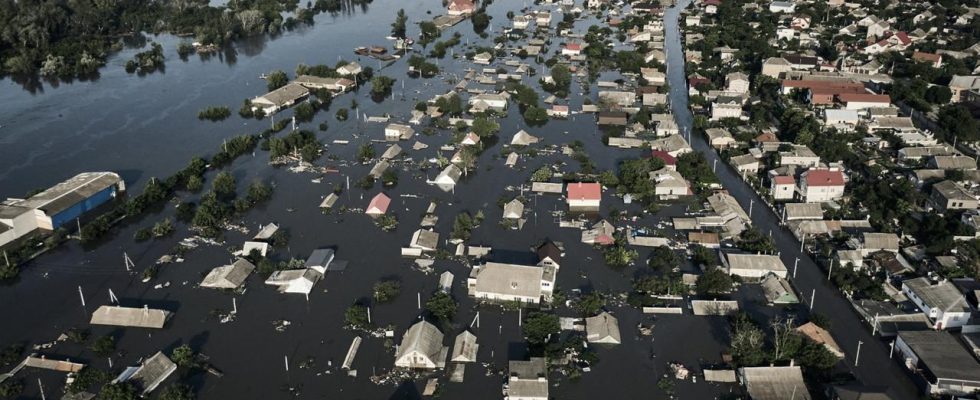The long-term consequences of the destruction of the Kakhovka dam are not yet foreseeable: The IAEA warns that the sinking level of the reservoir could threaten the Zaporizhia nuclear power plant. It is still unclear how the dam wall broke.
After the destruction of the Kachowka dam, the floods of a reservoir, which is four times the area of Lake Constance, pour down the river. The fact that the flooded lower reaches of the Dnipro marks the partially mined front line in Russia’s war against Ukraine makes evacuation and access for aid organizations even more difficult.
On the left bank of the river, occupied by Russia, immediately behind the destroyed dam wall is the now partly flooded town of Nowa Kachowka. According to the mayor, up to 100 people are trapped by the floods there alone. Vladimir Saldo, the de facto chief of administration of the Russian-occupied part of the Kherson region, declared a state of emergency.
Destruction of the Kachowka dam
Water levels in flood areas continue to rise
His deputy Tatyana Kusmich complained about the confusing situation on Russian state television late in the morning. According to the Ministry of Emergency Situations, around 900 people evacuated themselves yesterday. There are currently 350 people in the emergency shelters. “But the fact is that the situation doesn’t change every hour, but every half hour,” said Kusmitsch.
Falling level threatens Zaporizhia nuclear power plant
Up to 40,000 people on the side occupied by Russia are directly affected by the disaster. The long-term consequences for the population, the environment, the drinking water supply or agriculture, which are not yet fully foreseeable, also include this number, which Vladimir Saldo quoted: “The level of the Kakhovkoye reservoir near Energodar and the Zaporizhia region is much higher sunk than 3.5 meters.”
The International Atomic Energy Agency (IAEA) warned that in just a few days the level could be so low that cooling water could no longer be pumped into the nuclear power plant near Zaporizhia, which is occupied by Russian troops. At the moment this is not critical, because there is enough water in the well-filled reserve tank. Nevertheless, IAEA boss Rafael Grossi announced that he would like to visit the nuclear power plant next week.
Looking for culprits
In addition to the acute disaster relief, the search for the culprits continues. UN Secretary-General Antonio Guterres spoke of “another devastating consequence of the Russian invasion of Ukraine”.
But the United Nations does not have precise information about what caused the dam wall to collapse. There, the representatives of Russia and Ukraine accused each other of having committed this act of terrorism. Both top Russian politicians and investigative authorities and the country’s media directly and massively accused Ukraine.
Maria Zakharova, spokeswoman for the Russian Foreign Ministry, accuses Ukraine of not only shelling the Kakhovka hydroelectric power station, but also of deliberately bringing the water level in the reservoir to a critical level by opening the locks of the Dnepropetrovsk hydroelectric power station.
“We call on the world community to condemn the criminal acts of the Ukrainian authorities, which are increasingly inhuman in nature and pose a serious threat to regional and global security,” Zakhrova said.
To date, there is no clear evidence as to who is responsible for the catastrophe in southern Ukraine – and how exactly the dam wall ruptured.

